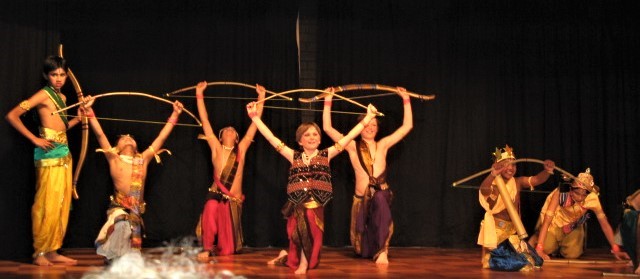What do Ramayana and Star Wars have in common?
The 1960s saw a boom in performing arts and arts organisations in India’s capital city New Delhi. Kathakali found its niche in the newly founded International Centre for Kathakali (ICK) and several traditional performances were staged under its aegis. Partly instigated by the arts funding bodies of the day, many contemporary themes were developed and presented by the ICK in the 1960s and the 1970s. This was the result of the untiring work of many dedicated connoisseurs, aficionados and supporters including my father, TM Bhaskaran Nedungadi and Shivashankara Menon. A great achievement was that a Kathakali troupe (yogam) was set up and this is running successfully to this day.
The first principal of this institute was the late Guru Punnathur Madhava Panicker. A gem of a Guru and an amazingly humble artist with a huge heart, he was a treasure trove of Kathakali. I was one of his first disciples in Delhi and had the good fortune to learn major roles including Nala (Nalacharitam), Bheema and Arjuna.
Performance was never the endgame, more the accrual of knowledge. It was, of course, not very evident to this teenager then. Now when I look back, I realise it provided a gateway to a language (language of Kerala theatre), a performance culture dating back centuries, and a grip on cultural history that encompassed religion and religious practices.
Moreover, it gave an insight into the Sanskrit theatre traditions. On the practical side, it provided me with the building blocks of the Kerala theatre arts, especially the dance variations in Kathakali such as Yuddha Vattam, Padapurappadu, Kalashams such as Ashta, Valia, Vattum Vechu; Saria and Kummi dances and many more. At every stage, even four decades down the track, this knowledge has prevailed.
Ramayana in foreign shores
On the recommendation of noted dance academic and historian Professor Ann David of Roehampton University in London, Jonathan Tickner, principal of the London School of Philosophy’s Erasmus School in Melbourne, invited me to give a lecture demonstration to the students.
The exceptional response to my presentation led to the principal’s request to teach dance at the school. This proved successful; I taught there for about 14 years and presented the entire school’s students in Ramayana and other themes.
The excitement of the children when building the bridge across to Lanka (Sethubandham) or when preparing for war and celebrations later were spectacular and unforgettable. A scene which stands out in my mind is King Dasharatha’s yagna for progeny with the entire school chanting the Gayatri Mantra.
The atmosphere was electric, it did not matter that Rama was a redhead and Sita a blonde, blue-eyed beauty. The children grasped the concept of abhinaya and filled me with a unique sense of peace, calm and achievement in communicating across cultures.
This sense of achievement was complete when the children came to me and said they wanted to perform a non-mythological theme. I encouraged them to select one and not surprisingly, it was a scene from Star Wars. I worked with them and created a script and choreography.
The children put their and heart and soul into the production. I had my heart in my mouth when in the last scene, Luke Skywalker defeated the evil in Darth Vader by removing his mask, and the evil emperor was destroyed.
To my amazement and relief, many in the audience, including the parents, had tears in their eyes before they burst into a thundering applause.
My relief knew no end as I had debated internally for long before letting this young group deal with such an emotionally intense episode. The logic that let me go ahead was a hark back into Narasimhavatharam where the young Prahlada witnesses the disembowelling of the entrails of his father Hiraynakashipu by Lord Vishnu! This too was the victory of good over evil.
The accolades and the applause
Erasmus School’s theatre arts program, which had Shakespeare and Greek mythology, added the Ramayana, and presented these themes in rotation over the years. The success at Erasmus led to other schools such as East Bentleigh Primary School inviting me to develop Ramayana and other performance projects.
When I received the Order of Australia Medal (OAM) from the Governor General of Australia in 2009 for my service to the performing arts, a reception was held in Melbourne. The then High Commissioner of India in Australia, Her Excellency Sujatha Singh, spoke about the above contributions to the curricula in schools and highlighted the value and importance of arts in education. The reach through education is immense and beyond measure in any real terms. It is a welcome reflection of the strength of multiculturalism in Melbourne and Australia.
Photo credit: Tara Rajkumar archives

